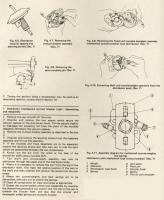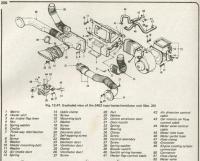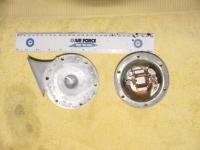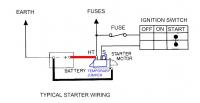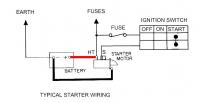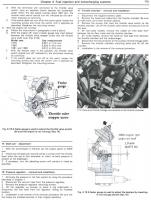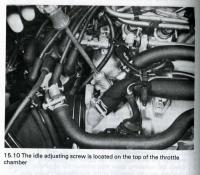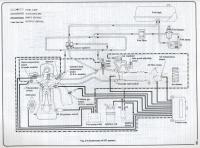Everything posted by Nissanman
-
Put OIL in Strut housing or NOT?
There is a distinct possibility, if no oil is present on the inside of the strut tube, of corrosion. [The OEM damper is essentially an oil filled strut tube with a top seal.] If you upend the strut and drain the oil or even wash them out with de-greaser, you are leaving the inside of the tube clean but ripe for corrosion. When I fit inserts, I simply leave the oil in the strut, drop the insert in [which will displace some oil], then fit the gland nut. I don't think the presence of that small amount of oil will harm anything and it may prevent the inside of the strut tube from corroding over the years:paranoid: Time will tell, I'm sure:)
-
Question about oil leak
If it is leaking at the thread [or block], then a sealant should go a long way to fixing the leak. However if it is leaking from the body of the sender, it is probably due for replacement. Clean up the area and check it now and then to determine where it is leaking from, then take the appropriate action. If you do remove it, try to get a wrench on to the hex head right up by the block. Don't try to unscrew it grasping the sender body, it may snap off:stupid:
-
The Grind
I'm referring to the pressure of the atmosphere aiding your foot since the vacuum is applied on the engine side of the booster diaphragm.
-
The Grind
Pedal effort will be greater since you no longer have that additional 14.7Lbs/sq" assisting you. As long as the vacuum line to the inlet manifold is securely sealed so air cannot enter the engine, all is well for a temporary fix.
-
Compression checking question
...and do it on an engine at normal operating temperature with all spark plugs removed to minimise the load on the starter motor:classic:
-
S-30 Basic Electrical Questions - 2
1. There should be a huge circular hole on the firewall. It is adjacent the re-enforcing panel for the pedal box, near the inner guard. 2. the connector slides sideways over the flat head section of the "T".
-
Adding a radiator overflow tank
I've got one like that in my Datsun B120 ute. Unfortunately, the hose that comes with it is prone to kinking shut if you have any tight radius curves. Simple and works like a charm:classic:
-
What is this part? Ignition gizmo.
Yes, that item is to protect the points from the arcing when the back EMF is generated. A similar component should be fitted at the Alternator output which is a radio suppression capacitor. That is the fella that suppresses the noise from the alternator from interfering with the radio reception:)
-
Exhaust Manifold Question
If you are referring to the surface that mates to the head, yes. Any competent Automotive machine shop should be able to surface grind the flanges to dead flat for you.
-
240z Valve Cover
I've got several in good condition if you are really desperate. I'm in Oz:ermm:
-
Distributor Question
Who knows what it originally was, but now it is old, thick and contaminated by the sound of it:surprised I would advise that you give everything a good de-grease and re-lube with a little general purpose grease. Be very careful if you separate the moveable and fixed plates, there are tiny ball bearings between them to allow the plates to rotate in relation to each other Extract from the Haynes Datsun 240/260/280Z Repair Manual, page 76: -
-
Fuel Pump Flow
I used one of these to fill a 2L surge tank. Carter LP fuel pump. If you uses a fairly large surge tank there will be that amount of fuel in reserve at all times for the HP pump to draw on. Use filters at the input and output of all pumps and they should last indefinitely barring electrical breakdown.
-
fuel pressure regulator for su carbs
Lots of info here. Instructions here. They do say "NOTE: This regulator is not recommended for pumps over 200 gallons per hour."
-
81 280zx 5 speed transmission - capacity?
Oil capacity: - 4 speed, 3 5/8pt [1.7L] 5 speed 4 1/4pt [2L] Reference: Haynes Datsun 280ZX Owners Workshop Manual.
-
MSD Blaster Coil help
According to the Summit Racing Equipment site, the Ballast Resistor should be included and used. MSD-8203
-
Heater cables - 73
-
Horns
Electrical horns will have an adjuster on them somewhere to optimize the tone, either a screw with locknut or perhaps a bendable contact arm. Some have it external to the works, others you have to dissemble to get to it. The principal is similar to a set of ignition points. A set of contacts are operated by the electro-magnetic operation of the diaphragm. Usually, the points get dirty or burnt and prevent the coil from energising correctly. They also have a resistor across them to quench the back EMF from the coil when the points open. This is designed to prevent the points from arcing during operation. Check to see if it is still intact and effective. From memory it is ~200ohm. You can see the contacts and spark quench resistor in the schematic attached. This horn requires dissembly to get to the adjuster.
-
Starter Doesn't Engage (out of nowhere)
You're right, my mistook:stupid: The START function on the IGN SWITCH also signals the main START relay and the ECU. Without those signals, no worky:dead:
-
Starter Doesn't Engage (out of nowhere)
Intermittent translates to ANNOYING!:tapemouth If it fails to start, there is no need to push the car. Jumper the solenoid S terminal to the main battery connection, HT, and starter will operate. Have the IGN key in the ON position and Handbrake firmly on and OUT OF GEAR. In other words, set the car up as you would normally but bypass the IGN START position with the bridging of the terminals. You only need a short length of 10A wire to do the deed:cool: The only wrinkle with this method, and lets face it, it is an emergency/temporary fix, is that the IGNITION BALLAST resistor is not switched out of circuit.
-
Starter Doesn't Engage (out of nowhere)
The starter is probably OK. When absolutely nothing happens like this, it indicates that the starter solenoid is not operating, probably due to a faulty IGN switch or associated wiring. You can check if the starter is capable of doing the job by temporarily bridging the large battery terminal HT on the starter to the starter solenoid spade S terminal. This is what the IGN switch does anyway when you turn it to START. The starter should kick in and crank the engine. Make sure you are out of gear with handbrake ON, IGN switch OFF. Then, as mentioned, find out why the IGN switch doesn't do what it should.
-
Wow, is this ugly.
Well, it doesn't look factory fresh but, it doesn't show any damage from oil, coolant or exhaust leaks either:) If you are going to rebuild the engine, make sure you do everything. It is not that much more expensive to do a complete tear down and bearing replacement etc. and you will then be confidant in having a fresh engine. Plus you can get the block cleaned and repainted to brighten it up:bulb:
-
Question about oil leak
The sender is screwed into the main oil gallery in the engine block. It won't be under any pressure, just a reservoir ready to drain. It will lose some oil when you remove the old one but if you are reasonably quick in doing the changeover it won't make much of a mess. What does come out will be minimal so top up is hardly necessary. Use some good quality thread sealant on the new one. It will help seal the connection and protect the threads from seizing in the engine block. If the fuel filter is transparent you can see if there are any contaminants in the base of it. Nissan suggests replacing the fuel filter every 6,000 miles, "if necessary after visual inspection". If you haven't done so, it would be wise to change the filter perhaps twice a year to ensure fuel delivery and quality is optimum:classic:
-
Question about oil leak
If you decide to replace it with a new one, just be very careful when unscrewing the leaky one. Gentle pressure with the correct size wrench on the hex thread at the very base of the sender, right up by the engine block. You don't want to snap the threaded nipple off. Some people have been there, done that:angry:
-
Spring Screw by TPS
-
Spring Screw by TPS
Assuming it is the 280Z you are referring to, the idle control screw is the one on top of the chamber. It acts on an air passage not the actual butterfly valve.





